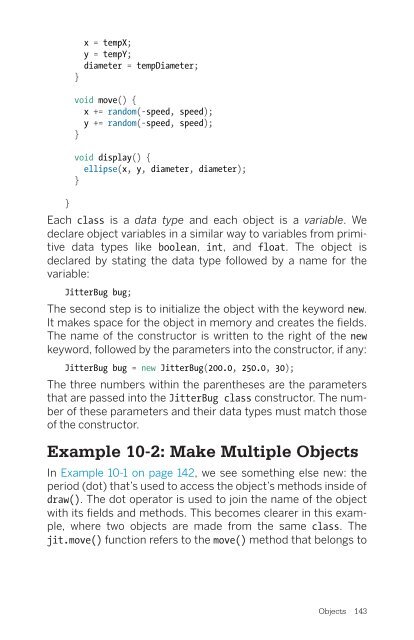www.ebook777.com
Make_Getting_Started_with_Processing_Second_Edition
Make_Getting_Started_with_Processing_Second_Edition
You also want an ePaper? Increase the reach of your titles
YUMPU automatically turns print PDFs into web optimized ePapers that Google loves.
}<br />
}<br />
x = tempX;<br />
y = tempY;<br />
diameter = tempDiameter;<br />
void move() {<br />
x += random(-speed, speed);<br />
y += random(-speed, speed);<br />
}<br />
void display() {<br />
ellipse(x, y, diameter, diameter);<br />
}<br />
Each class is a data type and each object is a variable. We<br />
declare object variables in a similar way to variables from primitive<br />
data types like boolean, int, and float. The object is<br />
declared by stating the data type followed by a name for the<br />
variable:<br />
JitterBug bug;<br />
The second step is to initialize the object with the keyword new.<br />
It makes space for the object in memory and creates the fields.<br />
The name of the constructor is written to the right of the new<br />
keyword, followed by the parameters into the constructor, if any:<br />
JitterBug bug = new JitterBug(200.0, 250.0, 30);<br />
The three numbers within the parentheses are the parameters<br />
that are passed into the JitterBug class constructor. The number<br />
of these parameters and their data types must match those<br />
of the constructor.<br />
Example 10-2: Make Multiple Objects<br />
In Example 10-1 on page 142, we see something else new: the<br />
period (dot) that’s used to access the object’s methods inside of<br />
draw(). The dot operator is used to join the name of the object<br />
with its fields and methods. This becomes clearer in this example,<br />
where two objects are made from the same class. The<br />
jit.move() function refers to the move() method that belongs to<br />
Objects 143



